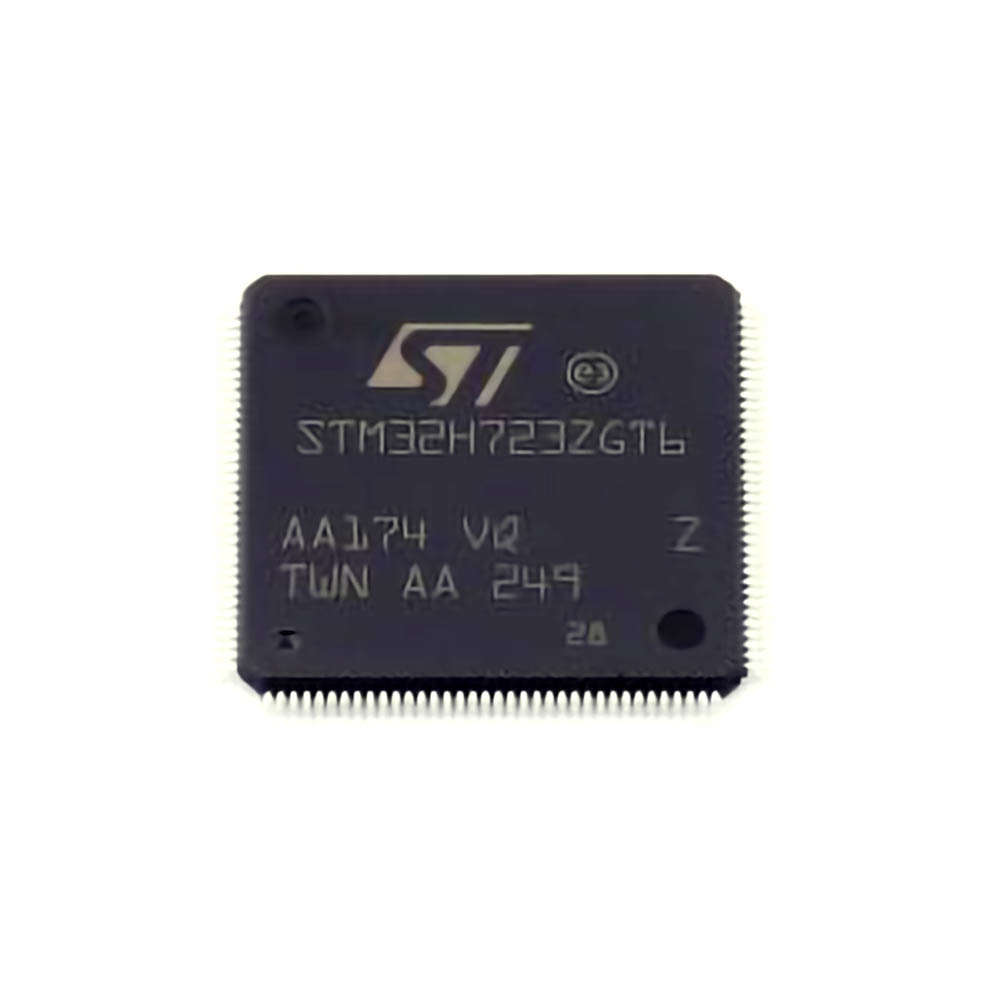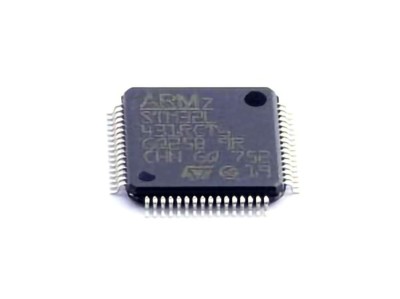
Common Issues with STM32H723ZGT6 and How to Fix Them
The STM32H723ZGT6 is a high-performance microcontroller from STMicroelectronics, part of the STM32H7 series. This series is designed to deliver exceptional performance, real-time capabilities, and advanced features for Embedded applications, from industrial automation to automotive systems. However, even the most robust microcontrollers can encounter issues during the development process. Here, we will highlight common problems and their solutions, helping you troubleshoot and resolve them with ease.
1. Power Supply Issues
Symptoms:
One of the most frequent problems encountered in embedded systems is power-related issues. With the STM32H723ZGT6, you may experience instability, non-booting behavior, or system resets if the power supply is inadequate or fluctuating.
Solutions:
Check Voltage Levels: Ensure that the supply voltage is within the recommended range, which for STM32H723ZGT6 is typically 3.3V. If you're using external components like voltage regulators, double-check that they are outputting a stable voltage.
Decoupling Capacitors : Add appropriate decoupling capacitor s (e.g., 0.1 µF ceramic capacitors) near the power pins of the microcontroller. These capacitors help filter noise and voltage fluctuations, ensuring stable operation.
Power Sequence: For more complex systems with multiple power rails, ensure that the power sequence is correct. The STM32H723ZGT6 may require proper sequencing for certain peripherals to start functioning correctly.
2. Boot Mode Configuration Issues
Symptoms:
If your STM32H723ZGT6 doesn't boot or is stuck in a reset state, the issue might lie in its boot mode configuration. The microcontroller has several boot options (e.g., boot from internal flash, external Memory , or system memory).
Solutions:
Check Boot Pins: The STM32H723ZGT6 uses certain pins (e.g., BOOT0 and BOOT1) to determine the boot source. Ensure that these pins are correctly configured. For example, if you're booting from internal flash, BOOT0 should be tied low (GND).
Use STM32CubeMX: You can use STM32CubeMX to configure the microcontroller’s boot settings. This tool allows you to easily set the correct configuration and generate initialization code.
3. Watchdog Timer Resets
Symptoms:
Unexpected resets or reboots during runtime can often be traced back to the watchdog timer. If the watchdog is not correctly fed or configured, the microcontroller will automatically reset itself after a predefined time.
Solutions:
Feed the Watchdog: Ensure that your software properly feeds (kicks) the watchdog timer at regular intervals. If the watchdog isn't fed in time, the microcontroller will trigger a reset.
Check Timeout Period: Make sure the watchdog timeout period is set appropriately for your application. A short timeout might cause unnecessary resets if the code execution is slow.
Disable the Watchdog (for debugging): Temporarily disable the watchdog during the debugging phase. This can help determine if the resets are due to watchdog triggers or another issue.
4. Clock Configuration Problems
Symptoms:
Incorrect clock configuration can lead to problems like slow performance, Communication issues, or failure to start peripherals correctly. The STM32H723ZGT6 comes with a flexible clock system, which, while powerful, can lead to errors if not configured properly.
Solutions:
Verify External Crystal/Clock Source: If you are using an external crystal oscillator, check that it is connected correctly and functioning as expected. Ensure the startup time of the external oscillator is appropriate.
Use STM32CubeMX for Clock Configuration: STM32CubeMX can be used to visually configure the clock tree and ensure that all components are set up correctly, avoiding issues like misconfigured PLL settings or incompatible clock speeds.
5. Peripheral Initialization Failures
Symptoms:
Peripheral devices, such as UART, SPI, or I2C, might fail to initialize or work erratically. This can be caused by improper configuration, incorrect pin assignments, or conflicts with other peripherals.
Solutions:
Pin Muxing: Ensure that the pins for the peripherals are correctly mapped and there are no conflicts. STM32H723ZGT6 supports advanced pin multiplexing, so make sure the pins are not accidentally assigned to another peripheral function.
Peripheral Initialization Code: Double-check the initialization code for the peripherals. Use STM32CubeMX to automatically generate the initialization code, which can reduce the chances of errors.
Use Debugging Tools: Use an oscilloscope or logic analyzer to monitor the signals for peripherals like UART or SPI. This can help identify if the peripherals are not being driven correctly or if there are issues with the signal integrity.
Advanced Troubleshooting and Solutions for STM32H723ZGT6
While the solutions discussed in Part 1 address the most common issues with the STM32H723ZGT6, there are also advanced debugging techniques and strategies that can help you overcome more complex problems.
6. Debugging with STM32CubeIDE
Symptoms:
When the microcontroller behaves unexpectedly or fails to perform specific tasks, debugging the software can be challenging. Without the right tools, identifying the root cause can become a time-consuming process.
Solutions:
Use STM32CubeIDE: STM32CubeIDE is an integrated development environment that allows you to debug your code in real-time. Use features like breakpoints, step-through debugging, and variable inspection to trace through your code and locate issues.
Serial Wire Debug (SWD): The STM32H723ZGT6 supports Serial Wire Debug (SWD), which provides fast and efficient debugging. Connect the microcontroller to a debugger such as the ST-Link V2 to perform in-depth debugging.
Debugging Peripheral Registers: Use STM32CubeIDE to inspect the peripheral registers during runtime. This can help identify issues like incorrect flag settings, misconfigured peripheral control registers, or incorrect interrupt handling.
7. Memory Corruption and Stack Overflows
Symptoms:
Memory corruption, including stack overflows, can occur if there are issues with memory allocation or buffer overruns. This is often seen in systems with large memory requirements or when using dynamic memory allocation.
Solutions:
Check Stack Size: Ensure that the stack size is sufficient for your application. You can adjust the stack size in the linker script to prevent stack overflows.
Memory Protection Unit (MPU): The STM32H723ZGT6 has a Memory Protection Unit (MPU) that can be configured to protect memory regions from being overwritten. Make use of the MPU to safeguard critical regions of memory.
Use Watchdog Timer to Detect Corruption: The watchdog timer can be used as a fail-safe to reset the microcontroller if memory corruption causes the system to behave unpredictably.
8. Communication Protocol Failures
Symptoms:
Communication failures in protocols like UART, SPI, or I2C can manifest as lost data, incorrect data transmission, or the inability to communicate with other devices.
Solutions:
Check Baud Rate and Settings: Ensure that the baud rate, data bits, parity, and stop bits are set correctly for UART communication. Mismatched settings on both sides of the communication will result in garbled or lost data.
Use Interrupts or DMA for Efficient Data Transfer: Using interrupts or Direct Memory Access (DMA) for data transfer can improve performance and reduce the likelihood of errors in communication protocols.
Ensure Pull-up/Pull-down Resistors are Present: For I2C communication, ensure that appropriate pull-up resistors are connected to the SDA and SCL lines.
9. Thermal Management
Symptoms:
Overheating can cause the STM32H723ZGT6 to become unstable or stop functioning altogether. Embedded systems, especially those used in demanding environments, are susceptible to thermal issues.
Solutions:
Monitor Temperature: If your system is running hot, consider adding temperature sensors to monitor the temperature of the microcontroller and surrounding components.
Improve Heat Dissipation: Ensure that the microcontroller is adequately cooled. This can involve using heat sinks, improving airflow in the enclosure, or reducing the workload of the microcontroller to lower heat generation.
Use Low-Power Modes: Utilize the low-power modes of the STM32H723ZGT6 to reduce power consumption and heat generation when full performance is not required.
10. Firmware Updates and Bug Fixes
Symptoms:
Occasionally, you might encounter issues that are related to bugs in the firmware, especially when using third-party libraries or operating systems.
Solutions:
Check for Firmware Updates: Regularly check for updates from STMicroelectronics and third-party library providers. New firmware versions may contain bug fixes or optimizations that address the issues you're facing.
Test with Latest Bootloader: Ensure that your system is running the latest bootloader. The bootloader often plays a critical role in initial device setup and firmware updates.
By following the steps outlined in this guide and utilizing debugging tools such as STM32CubeIDE and STM32CubeMX, you can quickly identify and resolve common issues with the STM32H723ZGT6 microcontroller. Troubleshooting embedded systems requires patience and attention to detail, but with the right strategies and resources, you'll be able to keep your projects running smoothly and efficiently.
If you are looking for more information on commonly used Electronic Components Models or about Electronic Components Product Catalog datasheets, compile all purchasing and CAD information into one place.


